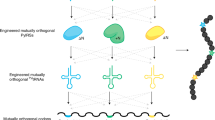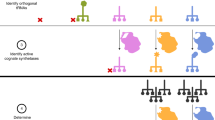Abstract
Pyrrolysine (Pyl), the 22nd natural amino acid, is genetically encoded by UAG and inserted into proteins by the unique suppressor tRNAPyl (ref. 1). The Methanosarcinaceae produce Pyl and express Pyl-containing methyltransferases that allow growth on methylamines2. Homologous methyltransferases and the Pyl biosynthetic and coding machinery are also found in two bacterial species1,3. Pyl coding is maintained by pyrrolysyl-tRNA synthetase (PylRS), which catalyses the formation of Pyl-tRNAPyl (refs 4, 5). Pyl is not a recent addition to the genetic code. PylRS was already present in the last universal common ancestor6; it then persisted in organisms that utilize methylamines as energy sources. Recent protein engineering efforts added non-canonical amino acids to the genetic code7,8. This technology relies on the directed evolution of an ‘orthogonal’ tRNA synthetase–tRNA pair in which an engineered aminoacyl-tRNA synthetase (aaRS) specifically and exclusively acylates the orthogonal tRNA with a non-canonical amino acid. For Pyl the natural evolutionary process developed such a system some 3 billion years ago. When transformed into Escherichia coli, Methanosarcina barkeri PylRS and tRNAPyl function as an orthogonal pair in vivo5,9. Here we show that Desulfitobacterium hafniense PylRS–tRNAPyl is an orthogonal pair in vitro and in vivo, and present the crystal structure of this orthogonal pair. The ancient emergence of PylRS–tRNAPyl allowed the evolution of unique structural features in both the protein and the tRNA. These structural elements manifest an intricate, specialized aaRS–tRNA interaction surface that is highly distinct from those observed in any other known aaRS–tRNA complex; it is this general property that underlies the molecular basis of orthogonality.
This is a preview of subscription content, access via your institution
Access options
Subscribe to this journal
Receive 51 print issues and online access
$199.00 per year
only $3.90 per issue
Buy this article
- Purchase on Springer Link
- Instant access to full article PDF
Prices may be subject to local taxes which are calculated during checkout




Similar content being viewed by others
References
Srinivasan, G., James, C. M. & Krzycki, J. A. Pyrrolysine encoded by UAG in Archaea: charging of a UAG-decoding specialized tRNA. Science 296, 1459–1462 (2002)
Krzycki, J. A. The direct genetic encoding of pyrrolysine. Curr. Opin. Microbiol. 8, 706–712 (2005)
Zhang, Y. & Gladyshev, V. N. High content of proteins containing 21st and 22nd amino acids, selenocysteine and pyrrolysine, in a symbiotic deltaproteobacterium of gutless worm Olavius algarvensis . Nucleic Acids Res. 35, 4952–4963 (2007)
Polycarpo, C. et al. An aminoacyl-tRNA synthetase that specifically activates pyrrolysine. Proc. Natl Acad. Sci. USA 101, 12450–12454 (2004)
Blight, S. K. et al. Direct charging of tRNACUA with pyrrolysine in vitro and in vivo . Nature 431, 333–335 (2004)
Kavran, J. M. et al. Structure of pyrrolysyl-tRNA synthetase, an archaeal enzyme for genetic code innovation. Proc. Natl Acad. Sci. USA 104, 11268–11273 (2007)
Wang, L., Xie, J. & Schultz, P. G. Expanding the genetic code. Annu. Rev. Biophys. Biomol. Struct. 35, 225–249 (2006)
Neumann, H., Peak-Chew, S. Y. & Chin, J. W. Genetically encoding Nε-acetyllysine in recombinant proteins. Nature Chem. Biol. 4, 232–234 (2008)
Herring, S. et al. The amino-terminal domain of pyrrolysyl-tRNA synthetase is dispensable in vitro but required for in vivo activity. FEBS Lett. 581, 3197–3203 (2007)
Yanagisawa, T. et al. Crystallographic studies on multiple conformational states of active-site loops in pyrrolysyl-tRNA synthetase. J. Mol. Biol. 378, 634–652 (2008)
Polycarpo, C. R. et al. Pyrrolysine analogues as substrates for pyrrolysyl-tRNA synthetase. FEBS Lett. 580, 6695–6700 (2006)
Yanofsky, C. & Horn, V. Tryptophan synthetase chain positions affected by mutations near the ends of the genetic map of trpA of Escherichia coli . J. Biol. Chem. 247, 4494–4498 (1972)
Murgola, E. J. tRNA, suppression, and the code. Annu. Rev. Genet. 19, 57–80 (1985)
O’Donoghue, P. & Luthey-Schulten, Z. On the evolution of structure in aminoacyl-tRNA synthetases. Microbiol. Mol. Biol. Rev. 67, 550–573 (2003)
Vasil’eva, I. A. & Moor, N. A. Interaction of aminoacyl-tRNA synthetases with tRNA: general principles and distinguishing characteristics of the high-molecular-weight substrate recognition. Biochemistry (Mosc.) 72, 247–263 (2007)
Ruff, M. et al. Class II aminoacyl transfer RNA synthetases: crystal structure of yeast aspartyl-tRNA synthetase complexed with tRNAAsp . Science 252, 1682–1689 (1991)
Goldgur, Y. et al. The crystal structure of phenylalanyl-tRNA synthetase from Thermus thermophilus complexed with cognate tRNAPhe . Structure 5, 59–68 (1997)
Cavarelli, J. et al. The active site of yeast aspartyl-tRNA synthetase: structural and functional aspects of the aminoacylation reaction. EMBO J. 13, 327–337 (1994)
Moor, N., Kotik-Kogan, O., Tworowski, D., Sukhanova, M. & Safro, M. The crystal structure of the ternary complex of phenylalanyl-tRNA synthetase with tRNAPhe and a phenylalanyl-adenylate analogue reveals a conformational switch of the CCA end. Biochemistry 45, 10572–10583 (2006)
Biou, V., Yaremchuk, A., Tukalo, M. & Cusack, S. The 2.9 Å crystal structure of T. thermophilus seryl-tRNA synthetase complexed with tRNASer . Science 263, 1404–1410 (1994)
Eiler, S., Dock-Bregeon, A., Moulinier, L., Thierry, J. C. & Moras, D. Synthesis of aspartyl-tRNAAsp in Escherichia coli–a snapshot of the second step. EMBO J. 18, 6532–6541 (1999)
Sankaranarayanan, R. et al. The structure of threonyl-tRNA synthetase-tRNAThr complex enlightens its repressor activity and reveals an essential zinc ion in the active site. Cell 97, 371–381 (1999)
Briand, C. et al. An intermediate step in the recognition of tRNAAsp by aspartyl-tRNA synthetase. J. Mol. Biol. 299, 1051–1060 (2000)
Théobald-Dietrich, A., Frugier, M., Giegé, R. & Rudinger-Thirion, J. Atypical archaeal tRNA pyrrolysine transcript behaves towards EF-Tu as a typical elongator tRNA. Nucleic Acids Res. 32, 1091–1096 (2004)
Ambrogelly, A. et al. Pyrrolysine is not hardwired for cotranslational insertion at UAG codons. Proc. Natl Acad. Sci. USA 104, 3141–3146 (2007)
Marck, C. & Grosjean, H. tRNomics: analysis of tRNA genes from 50 genomes of Eukarya, Archaea, and Bacteria reveals anticodon-sparing strategies and domain-specific features. RNA 8, 1189–1232 (2002)
Herring, S., Ambrogelly, A., Polycarpo, C. R. & Söll, D. Recognition of pyrrolysine tRNA by the Desulfitobacterium hafniense pyrrolysyl-tRNA synthetase. Nucleic Acids Res. 35, 1270–1278 (2007)
Lee, M. M. et al. Structure of Desulfitobacterium hafniense PylSc, a pyrrolysyl-tRNA synthetase. Biochem. Biophys. Res. Commun. 374, 470–474 (2008)
Vagin, A. & Teplyakov, A. MOLREP: an automated program for molecular replacement. J. Appl. Cryst. 30, 1022–1025 (1997)
Jones, T. A., Zou, J. Y., Cowan, S. W. & Kjeldgaard, M. Improved methods for building protein models in electron density maps and the location of errors in these models. Acta Crystallogr. A 47, 110–119 (1991)
Brünger, A. T. et al. Crystallography & NMR system: A new software suite for macromolecular structure determination. Acta Crystallogr. D Biol. Crystallogr. 54, 905–921 (1998)
Herring, S., Ambrogelly, A., Polycarpo, C. R. & Söll, D. Recognition of pyrrolysine tRNA by the Desulfitobacterium hafniense pyrrolysyl-tRNA synthetase. Nucleic Acids Res. 35, 1270–1278 (2007)
Polycarpo, C. R. et al. Pyrrolysine analogues as substrates for pyrrolysyl-tRNA synthetase. FEBS Lett. 580, 6695–6700 (2006)
Berman, H. M. et al. The Protein Data Bank. Nucleic Acids Res. 28, 235–242 (2000)
Yanofsky, C. & Horn, V. Tryptophan synthetase chain positions affected by mutations near the ends of the genetic map of trpA of Escherichia coli . J. Biol. Chem. 247, 4494–4498 (1972)
Murgola, E. J. tRNA, suppression, and the code. Annu. Rev. Genet. 19, 57–80 (1985)
Roberts, E., Eargle, J., Wright, D. & Luthey-Schulten, Z. MultiSeq: Unifying sequence and structure data for evolutionary analysis. BMC Bioinformatics 7, 382 (2006)
Markowitz, V. M. et al. IMG/M: a data management and analysis system for metagenomes. Nucleic Acids Res. 36, D534–D538 (2008)
Humphrey, W., Dalke, A. & Schulten, K. VMD: visual molecular dynamics. J. Mol. Graph. 14, 33–38 (1996)
Acknowledgements
We thank the beamline staff at BL41XU of SPring-8 (Harima, Japan) and NW12 of PF-AR (Tsukuba, Japan) for technical help during data collection. P.O. holds a National Science Foundation postdoctoral fellowship in Biological Informatics. This work was supported by grants from the Japan Science and Technology Agency (to O.N.), from the National Project on Protein Structural and Functional Analyses of the Ministry of Education, Culture, Sports, Science and Technology (to O.N.), from the Ministry of Education, Culture, Sports, Science and Technology (to R.I. and O.N.), from the Mitsubishi Foundation (to O.N.), from the Kurata Memorial Hitachi Science and Technology Foundation (to O.N.), from the National Institute of General Medical Sciences (to D.S.), from the Department of Energy (to D.S.), and from the National Science Foundation (to D.S.).
Author Contributions K.N. performed purification, crystallization and structure determination. S.G. and T.U. conducted biochemical analyses. R.I. performed molecular dynamics. Y.A., R.I. and O.N. assisted the structure determination. P.O’D. analysed the data and performed bioinformatic analysis. P.O’D., K.N., O.N. and D.S. wrote the paper. O.N. and D.S. conceived and supervised the work.
Author information
Authors and Affiliations
Corresponding authors
Supplementary information
Supplementary Information
This file contains a Supplementary Discussion, Supplementary References, Supplementary Figures 1-7 and Supplementary Tables 1-2 (PDF 10887 kb)
Rights and permissions
About this article
Cite this article
Nozawa, K., O’Donoghue, P., Gundllapalli, S. et al. Pyrrolysyl-tRNA synthetase–tRNAPyl structure reveals the molecular basis of orthogonality. Nature 457, 1163–1167 (2009). https://doi.org/10.1038/nature07611
Received:
Accepted:
Published:
Issue Date:
DOI: https://doi.org/10.1038/nature07611
This article is cited by
-
Virus-assisted directed evolution of enhanced suppressor tRNAs in mammalian cells
Nature Methods (2023)
-
Quintuply orthogonal pyrrolysyl-tRNA synthetase/tRNAPyl pairs
Nature Chemistry (2023)
-
Cell-free Biosynthesis of Peptidomimetics
Biotechnology and Bioprocess Engineering (2023)
-
Restoration of dystrophin expression in mice by suppressing a nonsense mutation through the incorporation of unnatural amino acids
Nature Biomedical Engineering (2021)
-
Improved pyrrolysine biosynthesis through phage assisted non-continuous directed evolution of the complete pathway
Nature Communications (2021)
Comments
By submitting a comment you agree to abide by our Terms and Community Guidelines. If you find something abusive or that does not comply with our terms or guidelines please flag it as inappropriate.



